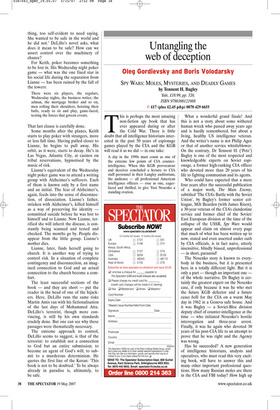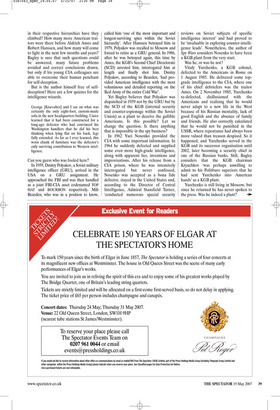Untangling the web of deception
Oleg Gordievsky and Boris Volodarsky
SPY WARS: MOLES, MYSTERIES, AND DEADLY GAMES by Tennent H. Bagley Yale, £18.99, pp. 320, ISBN 9780300121988 V £17 (plus £2.45 p&p) 0870 429 6655 This is perhaps the most amazing non-fiction spy book that has ever appeared during or after the Cold War. There is little doubt that all intelligence historians interested in the past 50 years of espionage games played by the CIA and the KGB will read it as we did — in one take:
A day in the 1990s must count as one of the extreme low points of CIA counterintelligence. When this KGB provocateur and deceiver concluded a lecture to CIA staff personnel in their Langley auditorium, the audience — all professional American intelligence officers — rose as one, eagerfaced and thrilled, to give Yuri Nosenko a standing ovation.
What a wonderful grand finale! And this is not a story about some withered human wreck who passed away years ago and is hardly remembered, but about a living, healthy US intelligence veteran. And the writer’s name is not Philip Agee or that of another service whistleblower. On the contrary, Dr Tennent H. (‘Pete’) Bagley is one of the most respected and knowledgeable experts on Soviet espionage, a former high-ranking CIA officer who devoted more than 20 years of his life to fighting communism and its agents.
Who could have expected that a mere four years after the successful publication of a major work, The Main Enemy, subtitled ‘The CIA’s Battle with the Soviet Union’, by Bagley’s former senior colleague, Milt Bearden (with James Risen), a 30-year veteran of the CIA’s clandestine service and former chief of the Soviet/ East European division at the time of the collapse of the USSR, Spy Wars would appear and claim on almost every page that much of what has been written up to now, stated and even asserted under oath by CIA officials, is in fact naive, utterly insensitive, blindly biased, unprofessional — in short, paranoid!
The Nosenko story is known to everybody in the business, but it is presented here in a totally different light. But it is only a part — though an important one of the whole narrative. Dr Bagley is certainly the greatest expert on the Nosenko case, if only because it was he who met the future KGB defector and a future casus belli for the CIA on a warm May day in 1962 in a Geneva safe house. And it was Bagley — a Soviet-Bloc division deputy chief of counter-intelligence at the time — who initiated Nosenko’s hostile interrogation and three-year arrest. Finally, it was he again who devoted 30 years of his post-CIA life to an attempt to prove that he was right and the Agency was wrong.
Has he succeeded? A new generation of intelligence historians, analysts and operatives, who must read this very exciting book, will have to answer this and many other important professional questions. How many Russian moles are there in the CIA and FBI today? How high up in their respective hierarchies have they climbed? How many more American traitors were there before Aldrich Ames and Robert Hanssen, and how many will come to light in the next few months and years? Bagley is sure that such questions could be answered, many future problems avoided and correct conclusions drawn, but only if his young CIA colleagues are able to overcome their human penchant for self-deception.
But is the author himself free of selfdeception? Here are a few quizzes for the intelligence wizards.
George [Kisevalter] and I sat on what was certainly the only eight-foot, custom-made sofa in the new headquarters building. I later learned that it had been constructed for a long-ago defector who had convinced his Washington handlers that he did his best thinking when lying flat on his back, legs fully extended. As far as I ever learned, this worn chunk of furniture was the defector’s only surviving contribution to Western intelligence.
Can you guess who was fooled here?
In 1959, Dmitry Polyakov, a Soviet military intelligence officer (GRU), arrived in the USA on a GRU assignment. He approached the FBI and was then handled as a joint FBI-CIA asset codenamed TOP HAT and BOURBON respectively. Milt Bearden, who was in a position to know, called him ‘one of the most important and longest-surviving spies within the Soviet hierarchy’. After Hanssen betrayed him in 1979, Polyakov was recalled to Moscow and forced to retire as a GRU general. In 1986, after he was betrayed again, this time by Ames, the KGB’s Second Chief Directorate (SCD) arrested him, interrogated him at length and finally shot him. Dmitry Polyakov, according to Bearden, ‘had provided American intelligence with the most voluminous and detailed reporting on the Red Army of the entire Cold War’.
Yet Bagley believes that Polyakov was dispatched in 1959 not by the GRU but by the SCD of the KGB (internal security and counter-espionage within the Soviet Union) as a plant to deceive the gullible Americans. Is this possible? Let us change the question. Is there anything that is impossible in the spy business?
In 1962 Yuri Nosenko provided the CIA with some important information. In 1964 he suddenly defected and supplied some even more high-grade intelligence, along with apparent lies, inventions and improvisations. After his release from a CIA prison, where he was intensively interrogated but never confessed, Nosenko was accepted as a bona fide defector, stayed in the United States and, according to the Director of Central Intelligence, Admiral Stansfield Turner, ‘conducted numerous special security reviews on Soviet subjects of specific intelligence interest’ and had proved to be ‘invaluable in exploring counter-intelligence leads’. Nonetheless, the author of Spy Wars considers Nosenko to have been a KGB plant from the very start.
Was he, or was he not?
Vitaly Yurchenko, a KGB colonel, defected to the Americans in Rome on 1 August 1985. He delivered some topgrade intelligence to the CIA, where one of his chief debriefers was the traitor Ames. On 2 November 1985, Yurchenko re-defected, disillusioned with the Americans and realising that he would never adapt to a new life in the West because of his Russian mentality, lack of good English and the absence of family and friends. He also correctly calculated that he would not be punished in the USSR, where repentance had always been more valued than treason despised. So it happened, and Yurchenko served in the KGB and its successor organisation until 2002, later becoming a security chief in one of the Russian banks. Still, Bagley considers that the KGB chairman Kryuchkov ‘was perhaps unwilling to admit to his Politburo superiors that he had sent Yurchenko into American hands’ as a KGB plant.
Yurchenko is still living in Moscow, but since he returned he has never spoken to the press. Was he indeed a plant? There are many other such examples in the book, like the cases of Yuri Loginov, Yuri Krotkov, Oleg Bitov and Oleg Tumanov, who, ‘after 20 years of treason as an anti-Soviet broadcast editor of Radio Liberty in Munich, returned to Russia in 1986 — to be “forgiven” because of his “repentance”’. However, according to Oleg Kalugin, one of Tumanov’s chief handlers, the latter was recruited as a KGB agent shortly after his defection, successfully spied for Moscow for many years, and was urgently recalled only because of an apparent threat that he was about to be unmasked. Tumanov continued to work for the KGB even after the collapse of the Soviet Union.
In his new book, Bagley is as critical of his former CIA colleagues as he is of the Russian defectors, genuine or fake. In a very useful glossary (Appendix D), he mentions William Colby,
a CIA officer with Far Eastern experience who became director of Central Intelligence. Inexperienced in either Soviet or counter-intelligence matters, he resented and distrusted the influence and ideas of James Angleton and fired him. Colby played a major role in downgrading and discrediting counter-intelligence in CIA and in dispelling doubts about Yuri Nosenko.
Leonard McCoy was a CIA reports officer. Later he became deputy chief of the Counter-intelligence Staff. He became a ferocious defender of Yuri Nosenko’s bona fides and published and fed to investigative reporters false information promoting this viewpoint and attacking those with different views.
John L. Hart was a ‘CIA officer who had served in the Far East and later became head of its European division’. In sworn testimony, as the director’s personal envoy, Hart
publicly accused his former colleagues of fabricating a [Nosenko] case, torturing, misusing Agency techniques, and contemplating murder. He rated their performance as ‘zero’, ‘miserable’, and ‘abominable’.
After discussing the contents of this book with a visiting high-ranking US intelligence archivist, we realised that it could not have been published at a better time, while the Litvinenko case in London is still being investigated. One thing is beyond doubt — it is never too late, or too soon, to remind the ‘normal’ Western reader, as well as, and perhaps especially, all Western intelligence professionals, that the Russians are capable of extraordinarily wide-scale deception and that one has to be extremely vigilant if one is to avoid falling into their traps. As Dr Bagley correctly states, selfdeception is the bane of counter-intelligence.
The book is written in good idiomatic English and is supplied with a glossary, three appendices and a name index.












































































 Previous page
Previous page